Detection and Frequency Estimation of Frequency Hopping Spread Spectrum Signals Based on Channelized Modulated Wideband Converters
Abstract
:1. Introduction
- The support set of FHSS signals changes rapidly, which has critical real-time requirement.
- There are significant performance penalties under a low SNR.
2. Fundamental of FHSS Signals
Traditional Structure of FH System
3. MWC for FH Signal
3.1. Channelized MWC
- (1)
- There should be the ability to rapidly derive and refresh the support set.
- (2)
- There must be enough sampling points for a single hop to obtain adequate information for MWC and subsequent processing.
- (3)
- The whole spectrum of FHSS signal must be covered.

3.2. Structure Design of Channelized MWC
3.3. Improved Structure for Channelized MWC
3.4. Detection and Frequency Estimation of FH Signal
4. Numerical Simulations and Discussion
4.1. Channel Detection
4.2. Frequency Estimation
5. Conclusions
Author Contributions
Funding
Acknowledgments
Conflicts of Interest
Appendix A
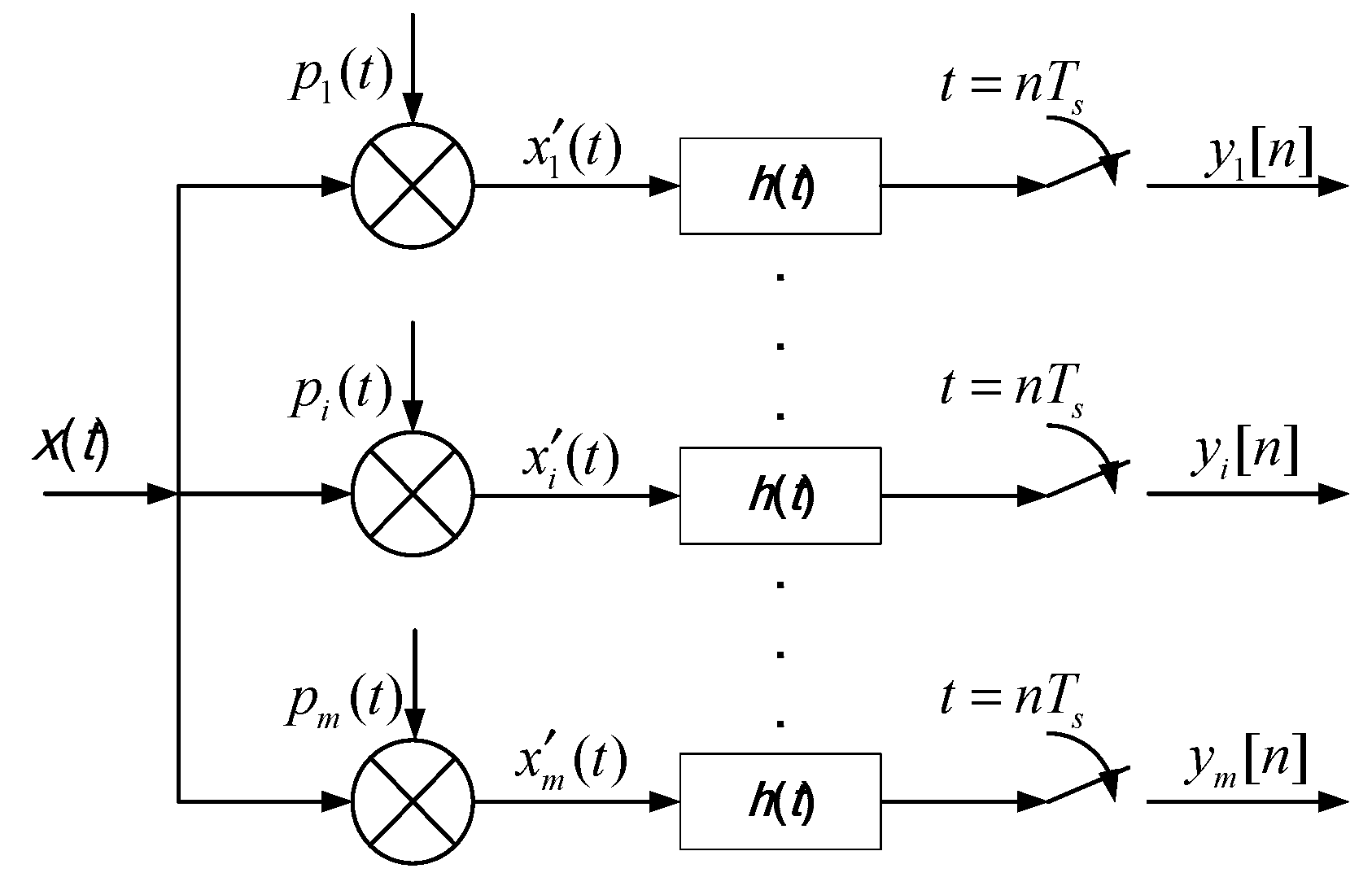
References
- Torrieri, D. Cellular frequency-hopping cdma systems. In Proceedings of the IEEE Vehicular Technology Conference, Houston, TX, USA, 16–20 May 1999; 6451034. Volume 912, pp. 919–925. [Google Scholar]
- Lv, J. Application of the wavelet rearrangement algorithm in the detection of time–frequency analysis of non-cooperative frequency hopping signals. In Proceedings of the IEEE International Conference on Wireless Communication and Sensor Network, Beijing, China, 21–25 October 2012; 13430309. Volume 1, pp. 18–26. [Google Scholar]
- Luan, H.; Hua, J. Blind detection of frequency hopping signal using time–frequency analysis. In Proceedings of the IEEE International Conference on Wireless Communications Networking and Mobile Computing, Chengdu, China, 23–25 September 2010; 11594302. Volume 1, pp. 1–4. [Google Scholar]
- Wael, G.; Aawatif, H. Joint time–frequency spectrum sensing for cognitive radio. In Proceedings of the IEEE International Symposium on Applied Sciences in Biomedical and Communication Technologies, Rome, Italy, 7–10 November 2010; 11777564. Volume 1, pp. 1–4. [Google Scholar] [CrossRef]
- Luo, S.E.; Luo, L.Y. Adaptive detection of an unknown fh signal based on image features. In Proceedings of the IEEE International Conference on Wireless Communications, Networking and Mobile Computing, Beijing, China, 24–26 September 2009; 10952126. Volume 1, pp. 1–4. [Google Scholar] [CrossRef]
- Sirotiya, M.; Banerjee, A. Detection and estimation of frequency hopping signals using wavelet transform. In Proceedings of the IEEE Uk-India-Idrc International Workshop on Cognitive Wireless Systems, New Delhi, India, 13–14 December 2010; 11852048. Volume 1, pp. 1–5. [Google Scholar]
- Miller, L.E.; Lee, J.S.; Torrieri, D.J. Frequency-hopping signal detection using partial band coverage. IEEE Trans. Aerosp. Electron. Syst. 1993, 29, 540–553. [Google Scholar] [CrossRef]
- Feng, L.; Namgoong, W. An adaptive maximally decimated channelized uwb receiver with cyclic prefix. IEEE Trans. Circuits Syst. I 2005, 52, 2165–2172. [Google Scholar] [CrossRef]
- Feng, L.; Namgoong, W. Oversampled channelized receiver for transmitted reference uwb system in the presences of narrowband interference. In Proceedings of the IEEE Signal Processing Systems, Austin, TX, USA, 13–15 October 2004; 8323843. Volume 1, pp. 48–52. [Google Scholar]
- Zhang, Y.J.; Liu, R.Y.; Song, H.J. A method of the detection of frequency-hopping signal based on channelized receiver in the complicated electromagnetic environment. In Proceedings of the IEEE International Conference on Intelligent Information Hiding and Multimedia Signal Processing, Adelaide, SA, Australia, 23–25 September 2015; 15804697. Volume 1, pp. 294–297. [Google Scholar] [CrossRef]
- Lehtomäki, J.J.; Juntti, M. Detection of frequency hopping signals using a sweeping channelized radiometer. Signal Process. 2005, 85, 2030–2043. [Google Scholar] [CrossRef]
- Kirolos, S.; Laska, J.; Wakin, M.; Duarte, M.; Baron, D.; Ragheb, T.; Massoud, Y.; Baraniuk, R. Analog-to-information conversion via random demodulation, Design. In Proceedings of the IEEE Applications, Integration and Software, Richardson, TX, USA, 29–30 October 2006; 9308666. Volume 1, pp. 71–74. [Google Scholar] [CrossRef]
- Kirolos, S.; Ragheb, T.; Laska, J.; Duarte, M.F.; Massoud, Y.; Baraniuk, R.G. Practical Issues in Implementing Analog-to-information Converters. In Proceedings of the IEEE International Workshop on System-On-Chip for Real-Time Applications, Cairo, Egypt, 27–29 December 2006; 9365961. Volume 1, pp. 141–146. [Google Scholar]
- Feng, P.; Bresler, Y. Spectrum-blind minimum-rate sampling and reconstruction ofmultiband signals. In Proceedings of the IEEE International Conference on Acoustics, Speech, and Signal Processing, Atlanta, GA, USA, 9 May 1996; 5478381. Volume 1683, pp. 1688–1691. [Google Scholar]
- Mishali, M.; Eldar, Y.C. From theory to practice: Sub-nyquist sampling of sparse wideband analog signals. IEEE J. Sel. Top. Signal Process. 2010, 4, 375–391. [Google Scholar] [CrossRef]
- Mishali, M.; Eldar, Y.C.; Dounaevsky, O.; Shoshan, E. Xampling: Analog to digital at sub-nyquist rates. IET Circuits Devices Syst. 2011, 5, 8–20. [Google Scholar] [CrossRef]
- Liu, W.; Huang, Z.; Wang, X.; Sun, W. Design of a single channel modulated wideband converter for wideband spectrum sensing: Theory, architecture and hardware implementation. Sensors 2017, 17, 1035. [Google Scholar] [CrossRef] [PubMed]
- Lv, W.; Wang, H.; Mu, S. Spectrum sensing using co-prime array based modulated wideband converter. Sensors 2017, 17, 1052. [Google Scholar] [CrossRef] [PubMed]
- Mishali, M.; Eldar, Y.C.; Tropp, J.A. Efficient sampling of sparse wideband analog signals. In Proceedings of the IEEE Convention of Electrical and Electronics Engineers, Eilat, Israel, 3–5 December 2008; 10442876. Volume 1, pp. 290–294. [Google Scholar] [CrossRef]
- Zhang, Y.; Yang, W.; Cheng, Y.; Mao, X.; Sheng, S. Compressed sensing-based fh-bpsk signals’ digital domain compressive sampling and reconstruction. In Proceedings of the IEEE International Conference on Signal Processing, Electric Engineering and Computer, Chengdu, China, 6–10 November 2016; 16757023. Volume 1, pp. 153–158. [Google Scholar] [CrossRef]
- Li, B.; Li, Y.; Zhu, Y.; Niu, Y.; Gao, Z. Compressive sensing based adaptive synchronous estimation for frequency hopping signal. In Proceedings of the IEEE International Conference on Mechatronic Sciences, Electric Engineering and Computer, Shengyang, China, 20–22 December 2013; 14547456. Volume 1, pp. 978–982. [Google Scholar] [CrossRef]
- Deng, F.; Zeng, F.; Li, R. Clustering-based compressive wide-band spectrum sensing in cognitive radio network. In Proceedings of the IEEE Fifth International Conference on Mobile Ad-Hoc and Sensor Networks, Fujian, China, 14–16 December 2009; 11135304. Volume 1, pp. 218–222. [Google Scholar] [CrossRef]
- Davenport, M.A.; Boufounos, P.T.; Wakin, M.B.; Baraniuk, R.G. Signal processings with compressive measurements. IEEE J. Sel. 2010, 4, 445–460. [Google Scholar] [CrossRef]
- Emam, H.A.; Salem, S.G.; Megahed, M.H.; Hamed, G.M.A. Detection and estimation of fhss signals using enhanced orthogonal matching pursuit. In Proceedings of the IEEE Radio Science Conference, Alexandria, Egypt, 13–16 March 2017; 16792538. Volume 1, pp. 353–361. [Google Scholar] [CrossRef]
- Yuan, J.; Tian, P.; Yu, H. The detection of frequency hopping signal using compressive sensing. In Proceedings of the IEEE International Conference on Information Engineering and Computer Science, Wuhan, China, 19–20 December 2009; 11033220. Volume 1, pp. 1–4. [Google Scholar] [CrossRef]
- Wu, J.; Liu, N.; Zhang, Y.; Shen, C. Blind detection of frequency hopping signal based on compressive sensing. In Proceedings of the IEEE International Conference on Consumer Electronics, Communications and Networks, Yichang, China, 21–23 April 2012; 12745732. Volume 1, pp. 1691–1694. [Google Scholar] [CrossRef]
- Sha, Z.; Liu, Z.; Huang, Z.; Zhou, Y. Covariance-based direction-of-arrival estimation of wideband coherent chirp signals via sparse representation. Sensors 2013, 13, 11490–11497. [Google Scholar] [CrossRef] [PubMed]
- Liu, F.; Marcellin, M.W.; Goodman, N.A.; Bilgin, A. Compressive sampling for detection of frequency-hopping spread spectrum signals. IEEE Trans. Signal Process. 2016, 64, 5513–5524. [Google Scholar] [CrossRef]

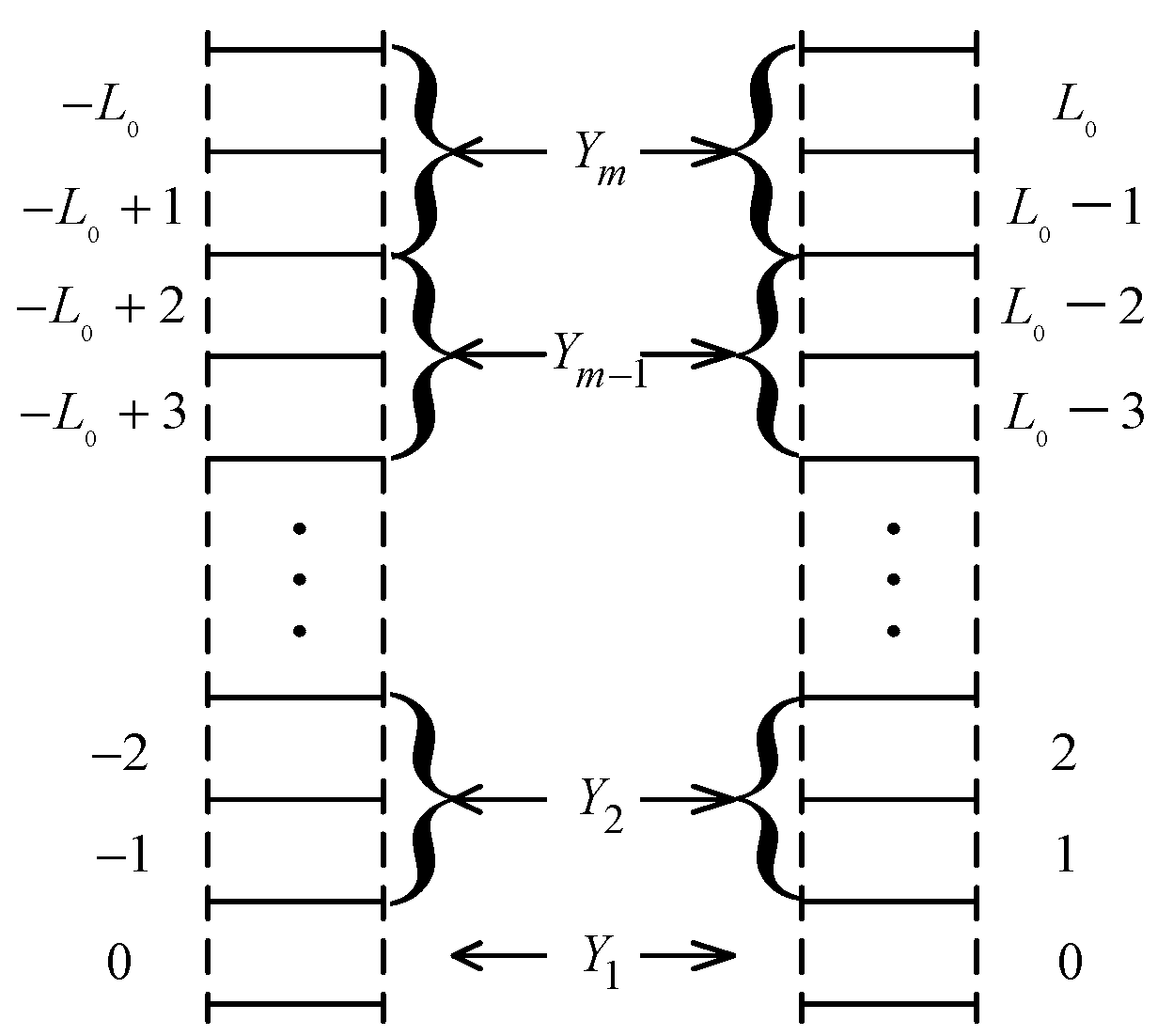
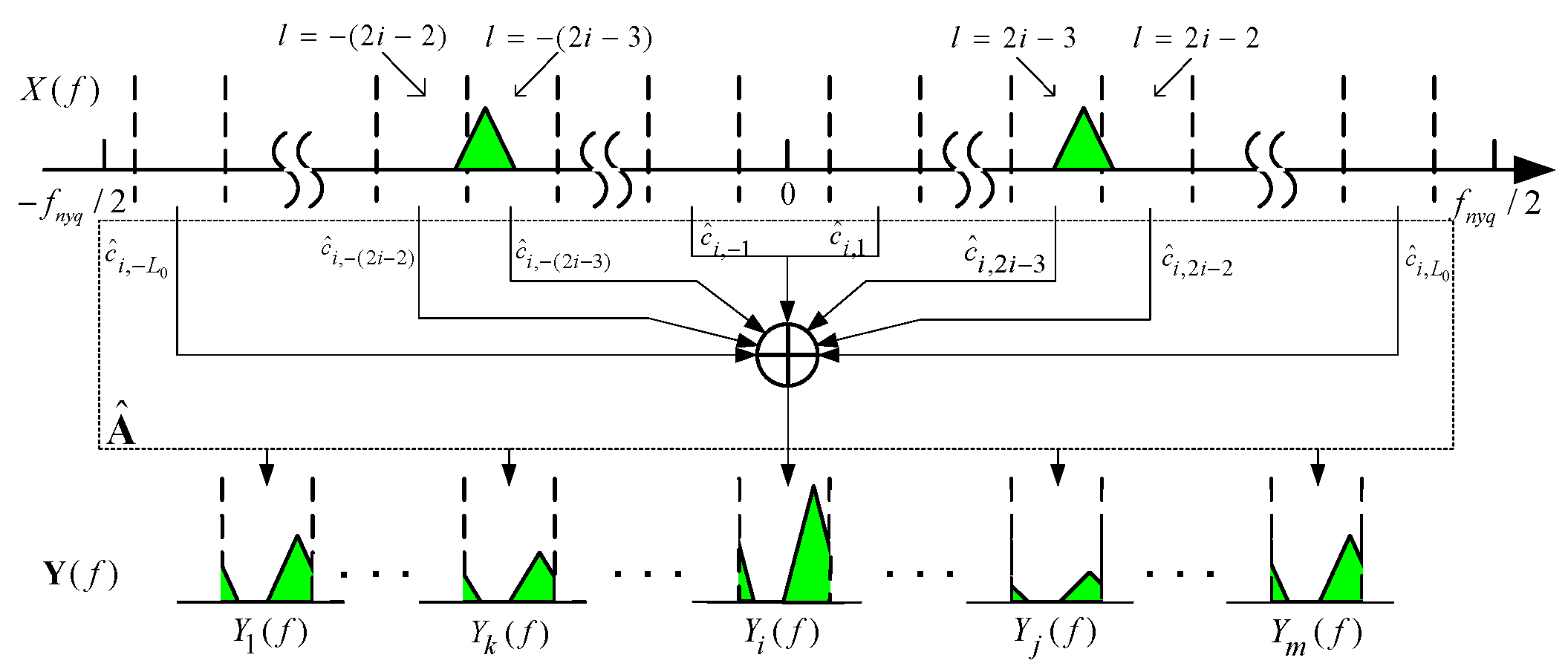
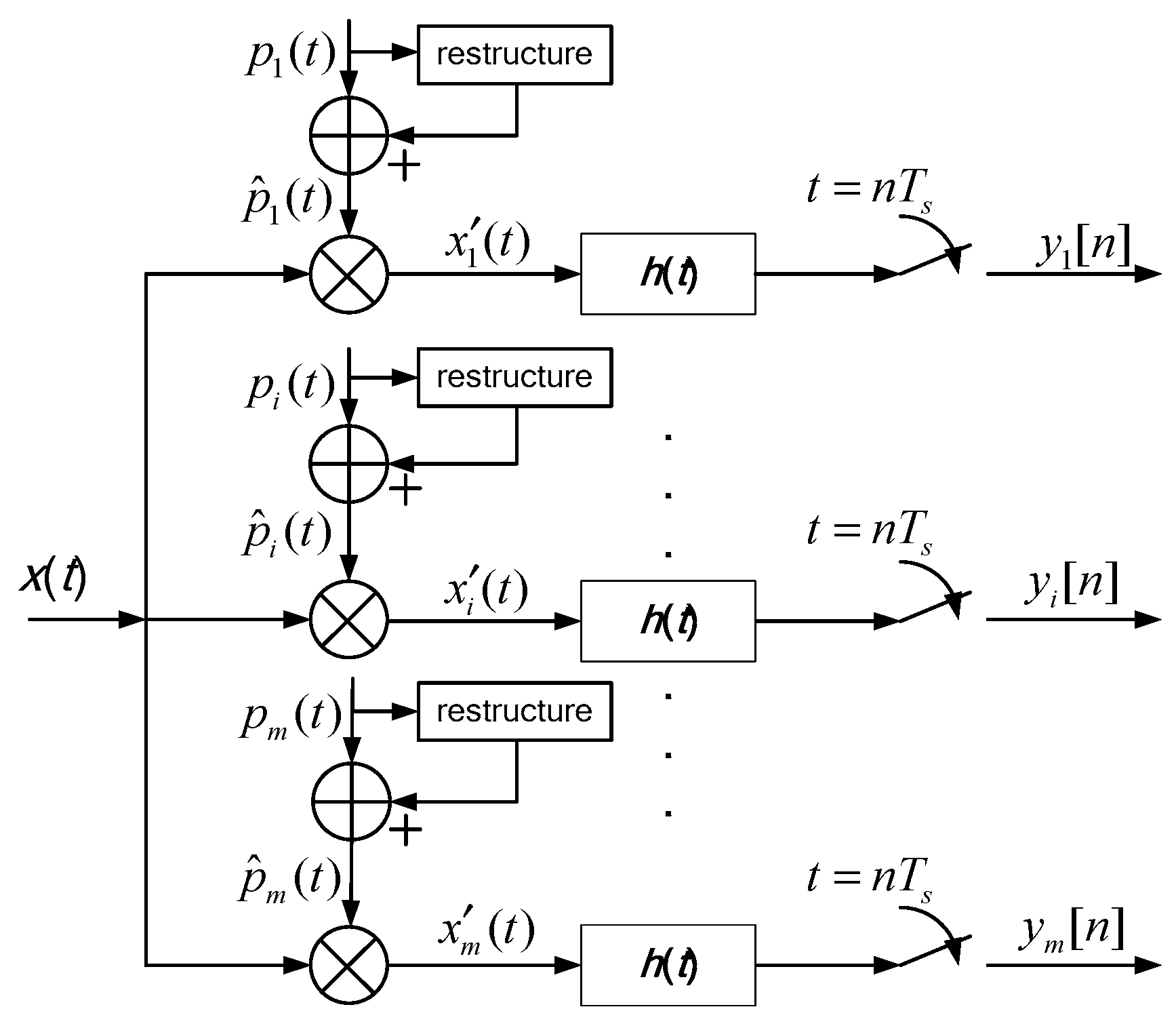
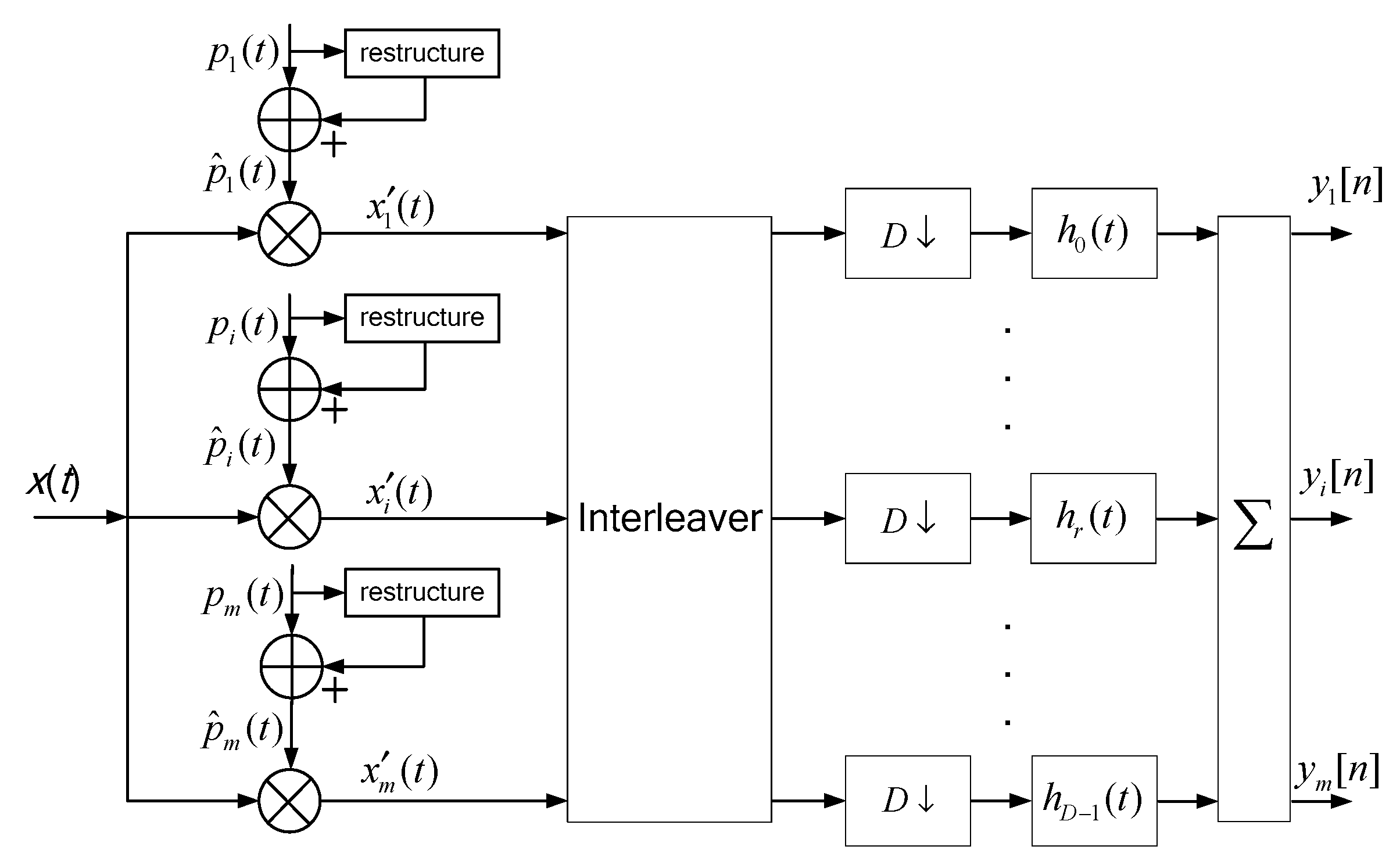
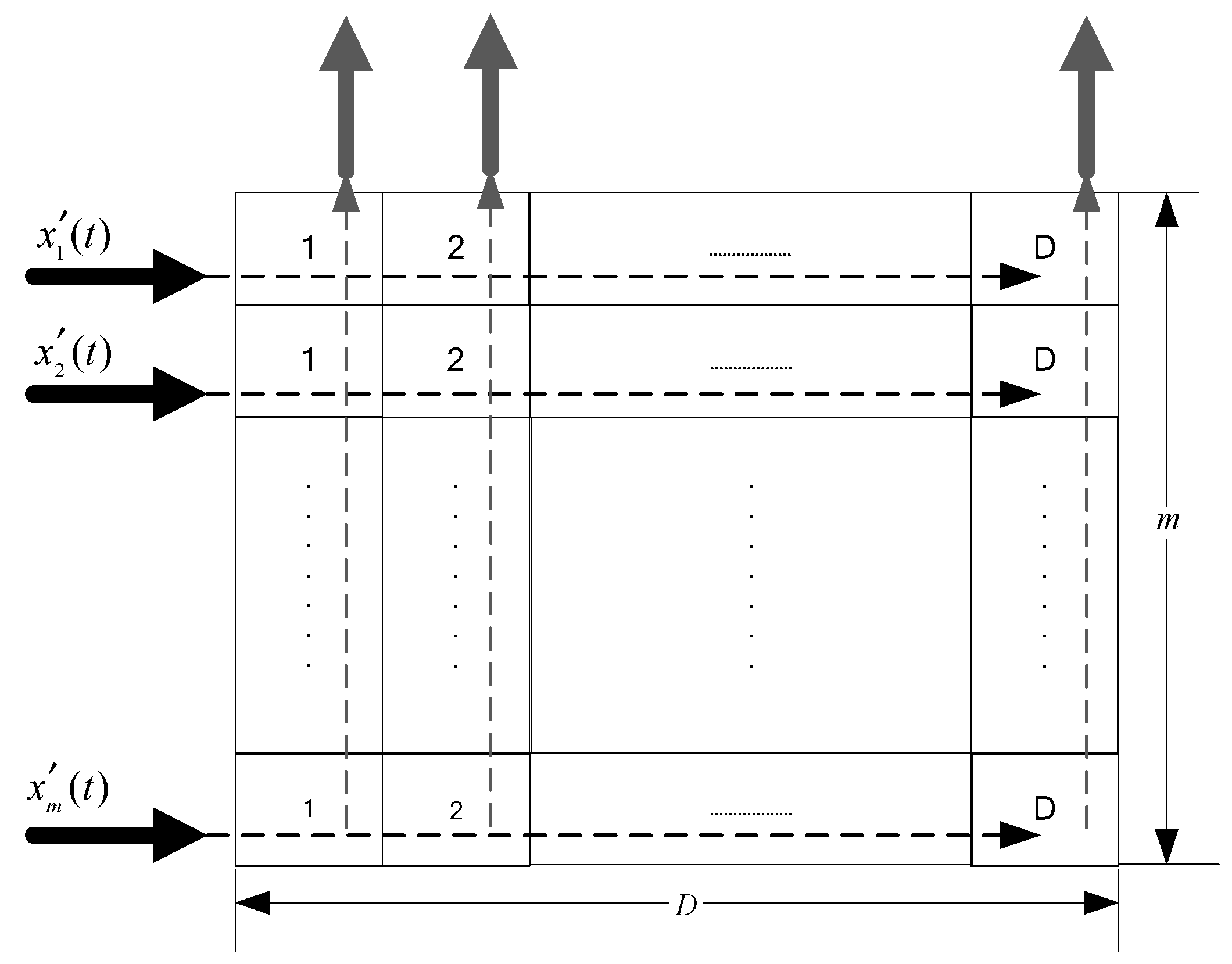
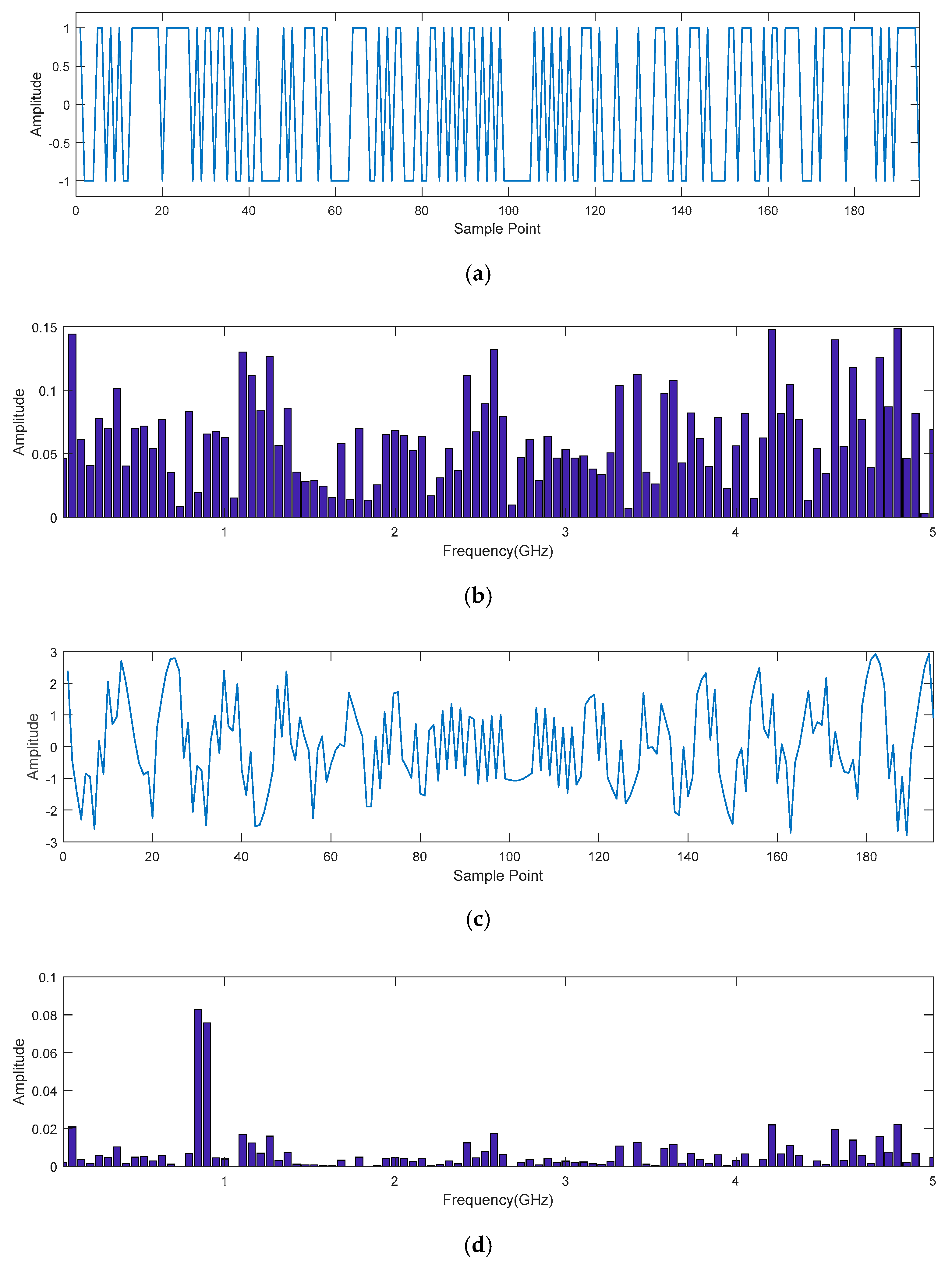


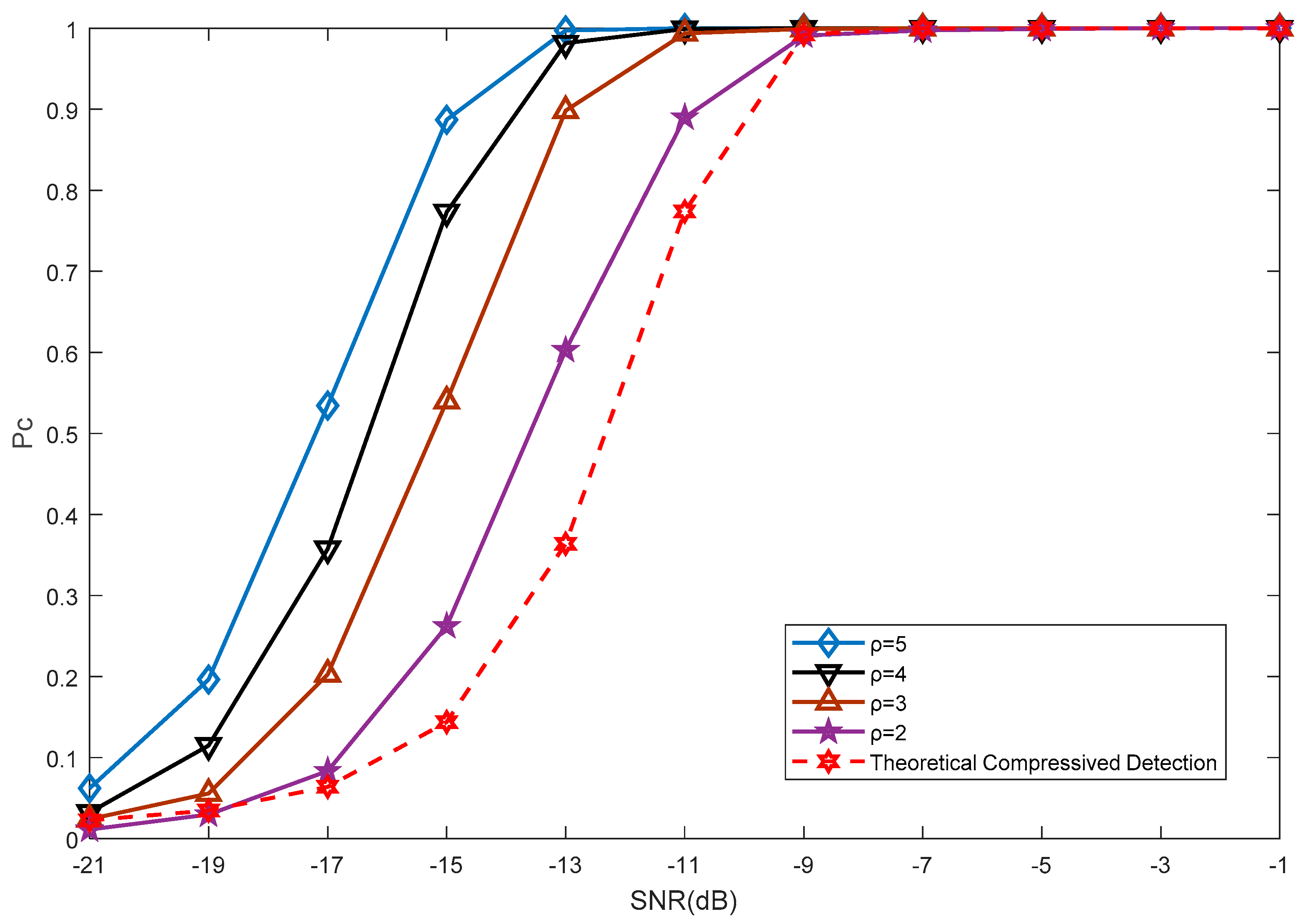
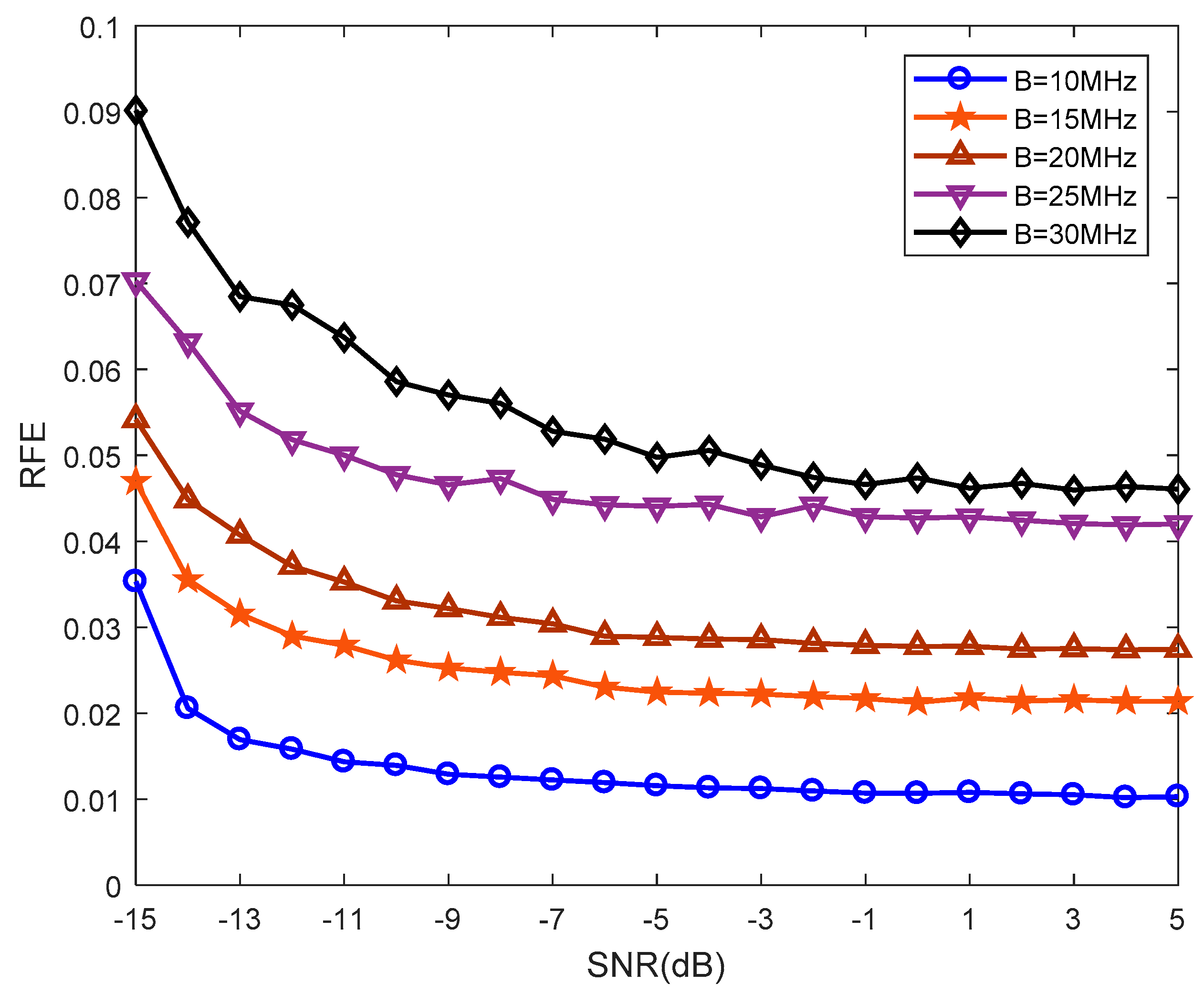
| Parameter | Value |
|---|---|
| Carrier Frequency | [2, 7 GHz] |
| Hop Rate | [10, 100 khop/s] |
| Single Hop Bandwidth | [5, 30 MHz] |
| Mode Type | DQPSK |
| Sub-band Number | 195 |
| Periodic Sequence Frequency | 51.3 MHz |
| Sampling Rate | 51.3 MHz |
| Channel Number | 50 |
| Length of FFT | 128 |
| Operation | OMP | Channelized MWC |
|---|---|---|
| Multiplication | ||
| Addition |
© 2018 by the authors. Licensee MDPI, Basel, Switzerland. This article is an open access article distributed under the terms and conditions of the Creative Commons Attribution (CC BY) license (http://creativecommons.org/licenses/by/4.0/).
Share and Cite
Lei, Z.; Yang, P.; Zheng, L. Detection and Frequency Estimation of Frequency Hopping Spread Spectrum Signals Based on Channelized Modulated Wideband Converters. Electronics 2018, 7, 170. https://doi.org/10.3390/electronics7090170
Lei Z, Yang P, Zheng L. Detection and Frequency Estimation of Frequency Hopping Spread Spectrum Signals Based on Channelized Modulated Wideband Converters. Electronics. 2018; 7(9):170. https://doi.org/10.3390/electronics7090170
Chicago/Turabian StyleLei, Ziwei, Peng Yang, and Linhua Zheng. 2018. "Detection and Frequency Estimation of Frequency Hopping Spread Spectrum Signals Based on Channelized Modulated Wideband Converters" Electronics 7, no. 9: 170. https://doi.org/10.3390/electronics7090170
APA StyleLei, Z., Yang, P., & Zheng, L. (2018). Detection and Frequency Estimation of Frequency Hopping Spread Spectrum Signals Based on Channelized Modulated Wideband Converters. Electronics, 7(9), 170. https://doi.org/10.3390/electronics7090170





